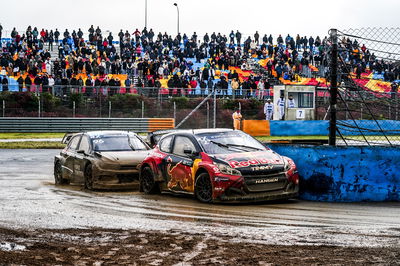Q&A: Nick Clipson (Hyundai WRC).
Hyundai unveiled its new Accent WRC? on the eve of the 2002 Tour de Corse, determined to take drivers Armin Schwarz and Freddy Loix closer to the top six and world championship points.
Although the new car bears an uncanny resemblance to its predecessor from the outside, Castrol team chief engineer Nick Clipson claims that much reworking has gone on 'under the skin'.
Q:
By looking at the car it is obvious there have only been minor changes to the exterior, but there are bigger changes beneath the surface. Can you outline the key changes for the WRC??
Hyundai unveiled its new Accent WRC? on the eve of the 2002 Tour de Corse, determined to take drivers Armin Schwarz and Freddy Loix closer to the top six and world championship points.
Although the new car bears an uncanny resemblance to its predecessor from the outside, Castrol team chief engineer Nick Clipson claims that much reworking has gone on 'under the skin'.
Q:
By looking at the car it is obvious there have only been minor changes to the exterior, but there are bigger changes beneath the surface. Can you outline the key changes for the WRC??
Nick Clipson:
The WRC? features a revised engine specification with significantly lighter components, improved suspension geometry, improved steering and better cooling efficiency. There are also a multitude of weight-saving improvements overall and the car has seen revisions to ease servicing. Internally the dash has been revised to provide more data to the drivers and engineers.
Q:
Talk us through the engine modifications....
NC:
The engine features lightweight mechanical components - crankshaft, flywheel, connecting rods, the latter designed to reduce friction within the engine. The bore and stroke has been revised, primarily to help with the redesign of the crankshaft. The car now has a different turbocharger to be more efficient at higher engine speed and the wastegate has been moved to help with turbo speed control and to lower the temperature. The airbox intake has been revised and positioned to give airbox temperatures closer to ambient temperatures. The engine is now also more easily accessible to improve serviceability.
Q:
Both Armin and Freddy have said that the revised suspension of the WRC? makes a big difference. Can you explain the improvements?
NC:
The suspension has been further refined in both geometry and hardware to maximise grip levels and to give the driver a better feeling for what the car is actually doing. The car is more stable as a result which gives the driver greater confidence. It also has the benefit of reducing tyre wear and thus keeping the car's performance more consistent over the long stages.
Q:
How has the steering improved?
NC:
The whole steering system has been developed to improve consistency and again help driver confidence. It has also been tuned to suit individual driver preferences.
Q:
Overheating can always be a problem in all types of rally cars. How have you worked to develop an optimum cooling system?
NC:
Further work in the wind tunnel has resulted in a refinement of last years cooling system to improve efficiency, with benefits resulting in the intercooling and engine air intake temperatures.
Q:
Explain the redesign of the ducts on the front of the car.
NC:
The ducts have been redesigned to give better flow of air through the intercooler and radiator and repositioning engine air intake to reduce intake temperatures. The air flow is now improved to cool the tarmac brakes more efficiently.
Q:
What changes have been made to the dashboard?
NC:
There is now much more data available to the driver and engineers and it is configurable to suit the individual drivers needs. For example Armin prefers to only see the gear he is using. Freddy in comparison wants to see the gear and the facility of the gearshift light to indicate when to change up a gear. If a driver chose he could view hydraulic pressure, oil temperature or water temperature, for example, but as it stands the drivers will only view engine parameter data if they need to react to it.










